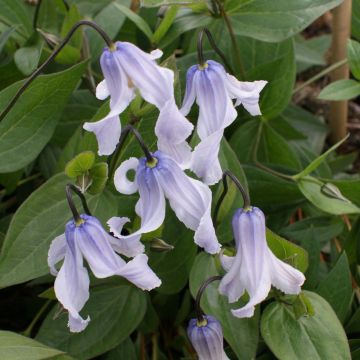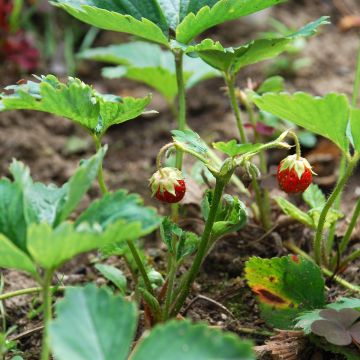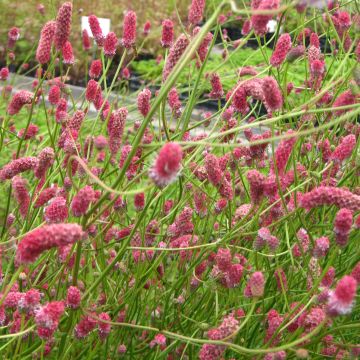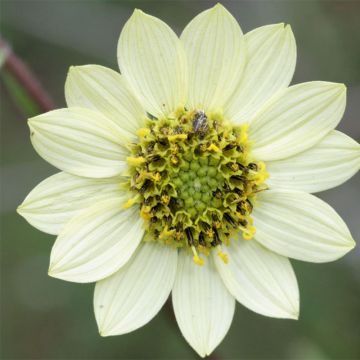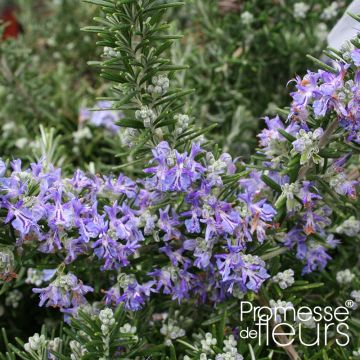

Verbesina alternifolia - Ironweed


Verbesina alternifolia - Ironweed


Verbesina alternifolia - Ironweed
Verbesina alternifolia - Ironweed
Verbesina alternifolia
Arkansas Ironweed
Hello, I am considering acquiring this young plant but I would like to know if it can be limited in height and if it can be shaped into a bushy form.
Ghislaine 38, 24/09/2023
Special offer!
Receive a €20 voucher for any order over €90 (excluding delivery costs, credit notes, and plastic-free options)!
1- Add your favorite plants to your cart.
2- Once you have reached €90, confirm your order (you can even choose the delivery date!).
3- As soon as your order is shipped, you will receive an email containing your voucher code, valid for 3 months (90 days).
Your voucher is unique and can only be used once, for any order with a minimum value of €20, excluding delivery costs.
Can be combined with other current offers, non-divisible and non-refundable.
Home or relay delivery (depending on size and destination)
Schedule delivery date,
and select date in basket
This plant carries a 12 months recovery warranty
More information
We guarantee the quality of our plants for a full growing cycle, and will replace at our expense any plant that fails to recover under normal climatic and planting conditions.
Would this plant suit my garden?
Set up your Plantfit profile →
Description
Verbesina alternifolia is a rhizomatous perennial giant with a wild and rustic appearance. It is robust and easy to grow and forms a solid and vigorous crown, from which tall 2 to 3 m (7 to 10ft) high stems emerge, bearing umbels of golden yellow flowers with drooping petals, and a prominent large, yellow-green heart. It will brighten up borders at the end of the season with its beautiful bright flowers!
Native to wooded areas in the east and north of North America, Verbesina alternifolia, also known by its former name Actinomeris alternifolia, belongs to the aster family. This giant herbaceous perennial forms a robust and woody crown, spreading through long rhizomes. From this clump winged, upright and stiff stems rise 2 to 3 metres (7 to 10 feet), branching towards the top. The leaves are alternate (as its Latin name alternifolia indicates), long and narrow, with slightly toothed edges. The upper surface of the leaves is medium green and rough in texture, while the lower surface is light green with white hairs on the main veins. At the top of the stems loose corymbs of terminal heads appear from August to October. The slightly fragrant, bright yellow flowers have drooping petals and a prominent greenish heart. They are nectar-rich and attract many pollinating insects. After flowering, achenes are produced and greatly appreciated by birds.
This giant perennial, with its wild and rustic appearance, should be planted in full sun or partial shade in good garden soil. Given its large dimensions, it is best planted among bushes to fill empty spaces, and at the back of borders, where its late flowering will make a sensation alongside tall Asters, Japanese Anemones, Grasses, Verbascums, and Vervain of Buenos Aires. Its large size will structure your borders, but you can also plant it as a standalone specimen where its flowers will look spectacular.
Report an error about the product description
Verbesina alternifolia - Ironweed in pictures
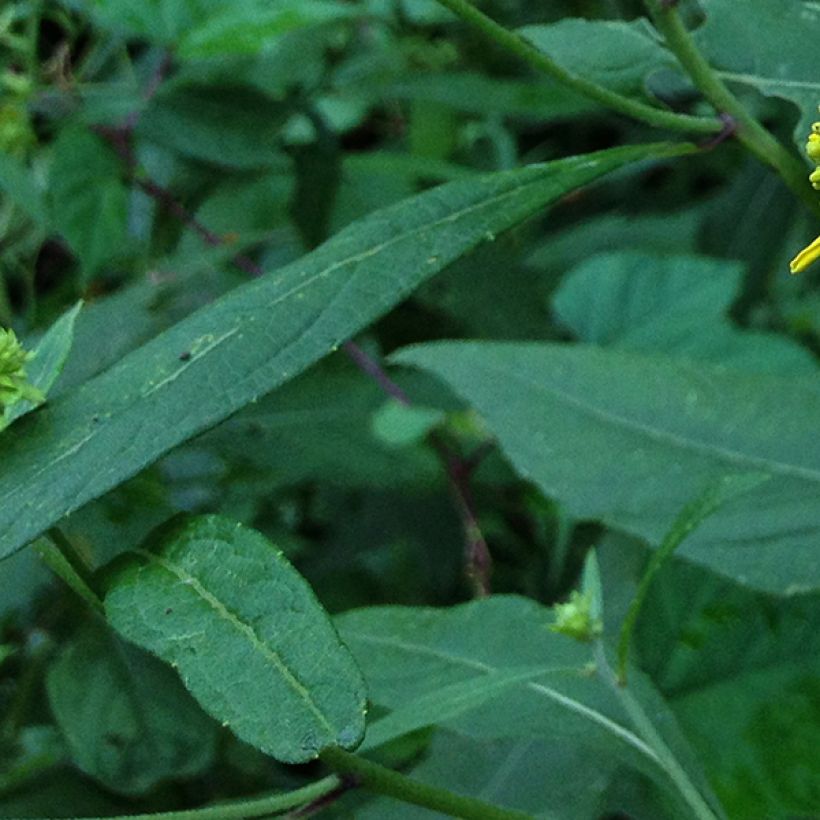

Flowering
Foliage
Plant habit
Botanical data
Verbesina
alternifolia
Asteraceae
Arkansas Ironweed
North America
Other Perennials A to Z
View all →Planting and care
Verbena alternifolia is easy to grow, low maintenance, and very robust and thrives in full sun or partial shade, in moist, fertile, and organic-rich soil, but can also tolerate drier conditions and poorer soil. It is extremely hardy and can withstand temperatures below -15°C (5°F). Sometimes, the lower leaves may drop during hot and dry weather, and there may be occasional powdery mildew attacks. It spreads through rhizomes and can also self-seed.
Planting period
Intended location
Care
Planting & care advice
-
, onOrder confirmed
Reply from on Promesse de fleurs
Similar products
Haven't found what you were looking for?
Hardiness is the lowest winter temperature a plant can endure without suffering serious damage or even dying. However, hardiness is affected by location (a sheltered area, such as a patio), protection (winter cover) and soil type (hardiness is improved by well-drained soil).

Photo Sharing Terms & Conditions
In order to encourage gardeners to interact and share their experiences, Promesse de fleurs offers various media enabling content to be uploaded onto its Site - in particular via the ‘Photo sharing’ module.
The User agrees to refrain from:
- Posting any content that is illegal, prejudicial, insulting, racist, inciteful to hatred, revisionist, contrary to public decency, that infringes on privacy or on the privacy rights of third parties, in particular the publicity rights of persons and goods, intellectual property rights, or the right to privacy.
- Submitting content on behalf of a third party;
- Impersonate the identity of a third party and/or publish any personal information about a third party;
In general, the User undertakes to refrain from any unethical behaviour.
All Content (in particular text, comments, files, images, photos, videos, creative works, etc.), which may be subject to property or intellectual property rights, image or other private rights, shall remain the property of the User, subject to the limited rights granted by the terms of the licence granted by Promesse de fleurs as stated below. Users are at liberty to publish or not to publish such Content on the Site, notably via the ‘Photo Sharing’ facility, and accept that this Content shall be made public and freely accessible, notably on the Internet.
Users further acknowledge, undertake to have ,and guarantee that they hold all necessary rights and permissions to publish such material on the Site, in particular with regard to the legislation in force pertaining to any privacy, property, intellectual property, image, or contractual rights, or rights of any other nature. By publishing such Content on the Site, Users acknowledge accepting full liability as publishers of the Content within the meaning of the law, and grant Promesse de fleurs, free of charge, an inclusive, worldwide licence for the said Content for the entire duration of its publication, including all reproduction, representation, up/downloading, displaying, performing, transmission, and storage rights.
Users also grant permission for their name to be linked to the Content and accept that this link may not always be made available.
By engaging in posting material, Users consent to their Content becoming automatically accessible on the Internet, in particular on other sites and/or blogs and/or web pages of the Promesse de fleurs site, including in particular social pages and the Promesse de fleurs catalogue.
Users may secure the removal of entrusted content free of charge by issuing a simple request via our contact form.
The flowering period indicated on our website applies to countries and regions located in USDA zone 8 (France, the United Kingdom, Ireland, the Netherlands, etc.)
It will vary according to where you live:
- In zones 9 to 10 (Italy, Spain, Greece, etc.), flowering will occur about 2 to 4 weeks earlier.
- In zones 6 to 7 (Germany, Poland, Slovenia, and lower mountainous regions), flowering will be delayed by 2 to 3 weeks.
- In zone 5 (Central Europe, Scandinavia), blooming will be delayed by 3 to 5 weeks.
In temperate climates, pruning of spring-flowering shrubs (forsythia, spireas, etc.) should be done just after flowering.
Pruning of summer-flowering shrubs (Indian Lilac, Perovskia, etc.) can be done in winter or spring.
In cold regions as well as with frost-sensitive plants, avoid pruning too early when severe frosts may still occur.
The planting period indicated on our website applies to countries and regions located in USDA zone 8 (France, United Kingdom, Ireland, Netherlands).
It will vary according to where you live:
- In Mediterranean zones (Marseille, Madrid, Milan, etc.), autumn and winter are the best planting periods.
- In continental zones (Strasbourg, Munich, Vienna, etc.), delay planting by 2 to 3 weeks in spring and bring it forward by 2 to 4 weeks in autumn.
- In mountainous regions (the Alps, Pyrenees, Carpathians, etc.), it is best to plant in late spring (May-June) or late summer (August-September).
The harvesting period indicated on our website applies to countries and regions in USDA zone 8 (France, England, Ireland, the Netherlands).
In colder areas (Scandinavia, Poland, Austria...) fruit and vegetable harvests are likely to be delayed by 3-4 weeks.
In warmer areas (Italy, Spain, Greece, etc.), harvesting will probably take place earlier, depending on weather conditions.
The sowing periods indicated on our website apply to countries and regions within USDA Zone 8 (France, UK, Ireland, Netherlands).
In colder areas (Scandinavia, Poland, Austria...), delay any outdoor sowing by 3-4 weeks, or sow under glass.
In warmer climes (Italy, Spain, Greece, etc.), bring outdoor sowing forward by a few weeks.





































